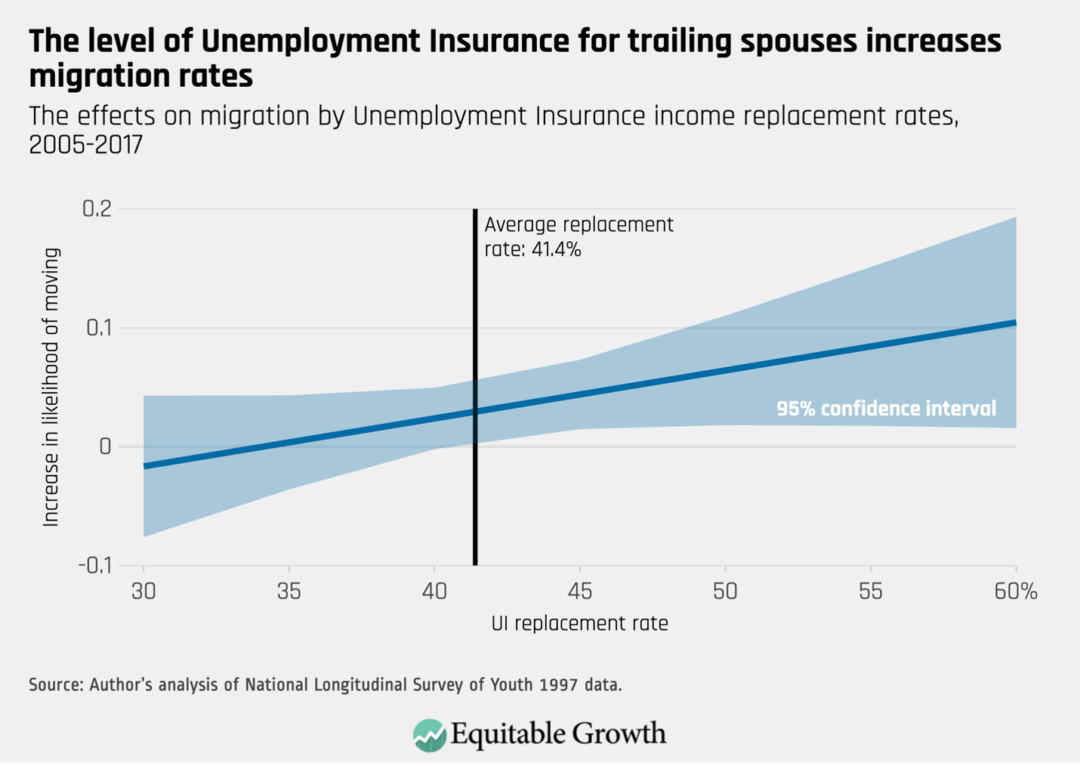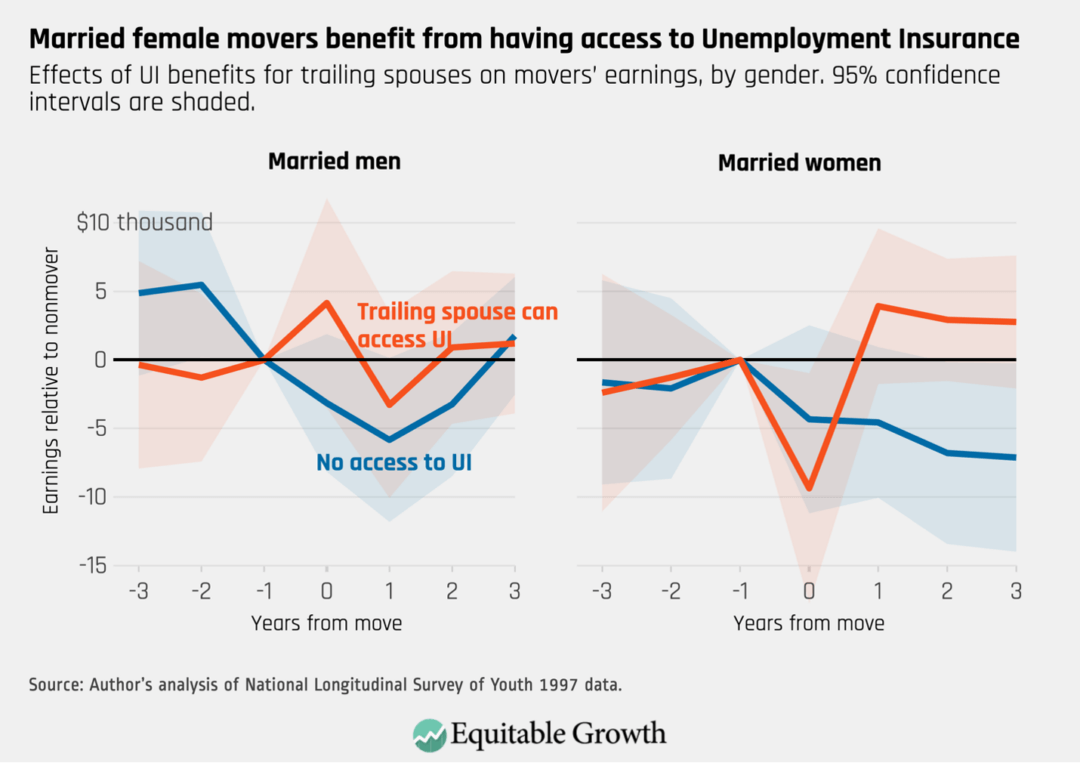Moving with two careers is hard, but Unemployment Insurance for trailing spouses can help

Where one works is tied to where one lives, and for many job searchers, changing jobs also means having to move. These joint job-location decisions are one way that a person might move up the job ladder or leave an economically depressed labor market, but these are decisions that aren’t as easily made for some types of households. Married dual-earner couples move less than single-earner households, in part because it is harder to move two jobs than one.
Oftentimes, one spouse ends up as a trailing spouse, moving without a job in hand or to a lower-paying job than they had prior to the move. This phenomenon also tends to be gendered, with women more likely to be trailing spouses. And a large array of research documents that married women tend to experience earnings losses and lower labor force participation following a move.
What role could policy play in changing how moves impact trailing spouses’ earnings? In my new working paper, titled “Dual-Earner Migration, Earnings, and Unemployment Insurance,” I study one such policy: Unemployment Insurance for trailing spouses. My research shows that having access to income support for a trailing spouse at the time of a move increases the likelihood that dual-earner households move and improves married women’s labor market outcomes after they move.
Workers who quit their jobs are typically not eligible for Unemployment Insurance, but some states make an exception if the reason they quit is because their spouse’s new job requires a move that makes commuting to their previous job impractical. Both within-state and across-state moves are eligible, and the worker collects Unemployment Insurance from the state in which they worked prior to the move.
As of 2017, 23 states included leaving a job due to a distant move for a spouse or partner’s career as one type of acceptable cause for leaving a job. This number is down from a peak of 27 states in 2010 but is much higher than pre-recession levels, when only 11 states had trailing spouse Unemployment Insurance provisions. Many states incorporated this provision as part of the Unemployment Insurance modernization requirements associated with receipt of federal funds during and immediately after the Great Recession of 2007–2009 under the American Recovery and Reinvestment Act. (See Figure 1.)
Figure 1
My paper first uses variations in where and when this policy was implemented to be able to make causal claims about how access to Unemployment Insurance for trailing spouses impacts whether a household moves. Because this policy was implemented simultaneously with other policies, I use single individuals as a natural control group in these analyses because a married couple would have additional incentives to move with this policy in place while an unmarried person should be equally likely to move or not move with or without the policy. By using individuals as a control group, as well as controlling for state and year fixed effects, I am able to control for other policies and economic conditions that might be changing at the same time as Unemployment Insurance benefits for trailing spouses that might affect migration decisions.
I find that having access to Unemployment Insurance for trailing spouses increases the likelihood that married individuals make long-distance moves of greater than 50 miles by 2 percentage points off a base rate of 5 percent and has the expected null effect on singles’ migration patterns. These effects, however, vary based on age and the level of Unemployment Insurance benefits. I show that the policy more broadly affects younger married couples ages 35 or below more than older couples. This is consistent with younger couples having higher migration rates overall, so we might thus expect to them to be more sensitive to policies such as Unemployment Insurance for trailing spouses.
Unemployment Insurance for trailing spouses also increases migration rates more in states with higher Unemployment Insurance benefits. The effect of the policy varies with the state’s income-replacement rate, but the effect of the policy is greater in states which replace a greater percentage of income, with a 1 percentage point increase in the replacement rate increasing the likelihood that a household moves under the policy by 0.4 percentage points. (See Figure 2.)
Figure 2

This policy also improves the labor market outcomes of trailing spouses following a move. Using an event study design and panel data from the National Longitudinal Survey of Youth, I look at how earnings change at the time of a move in the presence of the policy versus in the absence of the policy. Men’s earnings post-move do not change significantly in the presence of the policy, but I find that married female movers earn significantly more (between $4,500 and $12,000 more) 3 years post-move in the presence of the policy than similar female movers who are not eligible for Unemployment Insurance for trailing spouses due to their state of origin. (See Figure 3.)
Figure 3

As is evident in Figure 3, women who do nothave access to Unemployment Insurance for trailing spouses experience earnings losses following a move and never recoup those losses in the jobs they eventually find. In contrast, when women move with Unemployment Insurance eligibility in hand, they are able to rebound and ultimately end up earning similar levels to what would have been earning in the absence of a move. Some of these differences can be attributed to changes in their attachment to the labor force, yet I also find that women’s wages are higher 1 year post-move, suggesting that one reason this policy improves women’s earnings is that it allows women to search for longer rather than taking the first job they find in their new location, improving job quality and subsequent earnings.
These results, along with a more in-depth analysis of alternative subsidy policies discussed further in the paper, have important implications for how we design both Unemployment Insurance policy in general and policies meant to encourage migration in particular. First, this study demonstrates the benefits of access to Unemployment Insurance for a different population than most studies of Unemployment Insurance. Many past studies focus on access to Unemployment Insurance at the “intensive margins,” such as increases in Unemployment Insurance replacement rates or in the number of weeks of Unemployment Insurance eligibility. This paper instead focuses on access at the “extensive margin,” or who is eligible in the first place.
Those at the extensive margin of accessing Unemployment Insurance differ from those who are typically eligible in the first place. Women, in particular, are less likely to be eligible for Unemployment Insurance when leaving a job. This paper shows that female trailing spouses experience significant earnings gains from having access to Unemployment Insurance. This suggests that benefits to Unemployment Insurance for those typically not eligible may be larger than for the population usually studied. What constitutes a “voluntary” quit varies across demographic groups and revisiting what constitutes eligibility for Unemployment Insurance may address inequalities in access that contribute to gender differences in labor market attachment and earnings.
Second, policies meant to encourage “moving to opportunity” must consider the household as a whole rather than focusing on an individual’s decision-making process. Developing programs that support spouses’ job search following a move and expanding Unemployment Insurance for trailing spouses at the national level are two ways that U.S. policymakers could address the concerns faced by dual-earner households at the time of a move.
—Joanna Venator currently is a Ph.D. candidate in economics at the University of Wisconsin-Madison who will be joining the University of Rochester as a postdoctoral fellow in the fall of 2021 and becoming an assistant professor at Boston College starting in the summer of 2022.








